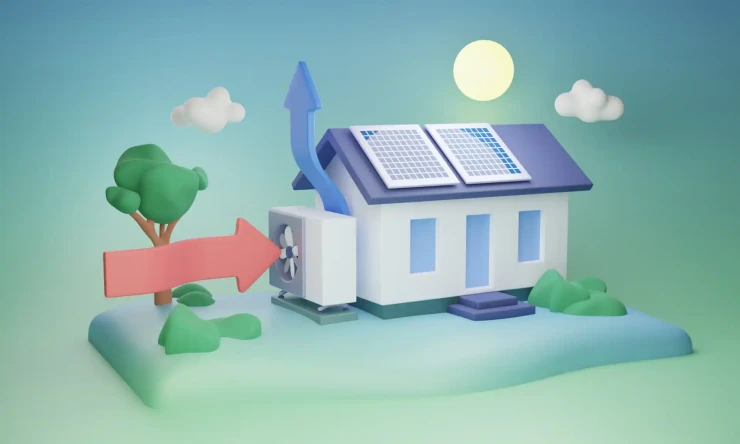
The International Energy Agency (IEA) has published a new edition of its 2021 Net Zero Roadmap which shows that reducing greenhouse gas emissions from the world’s energy sector to net zero and limiting global warming to 1.5°C remains possible.
However, the report warns that there are many milestones that still need to be reached if the Paris Agreement’s goal of capping global temperature increases at 1.5 degrees Celsius is to be achieved. Emissions rose as countries recovered from the Covid-19 pandemic and Russia’s war against Ukraine threw energy markets into chaos.
COMPARE PRICES FROM LOCAL INSTALLERS
Compare prices from local companies fast & free
Enter your postcode to compare quotes from leading professionals. We promise to keep your information Safe & Secure. Privacy Policy
August 2023 marked the hottest month recorded, after July 2023, emphasising the urgency to act. Despite new highs of 37 billion tonnes of CO2 emissions in 2022, it’s becoming increasingly possible that we will reach a peak in demand for coal, oil, and natural gas this decade due to the staggering growth in clean energy technology adoption and other positive developments.
The IEA’s latest report is comprehensive covering everything from fossil fuel projections and earlier net zero targets to heat pump policies and Carbon Capture and Storage prospects. The 2023 edition of the Roadmap sets out a global pathway for the energy sector, which is a major source of CO2 emissions, to achieve net zero emissions by 2050.
Since the first edition of the report, the cost of wind power, solar PV, heat pump, and battery technologies has continued to fall, and manufacturing capacity has ramped up. Particularly noteworthy is the growth in solar power capacity and electric car sales which is in line with a pathway towards net zero emissions globally by mid-century, as are industry plans for the roll-out of new manufacturing capacity for them. Governments have responded to the climate crisis and the global energy crisis by employing measures to promote clean energy technologies.
IEA Executive Director Fatih Birol noted:
"The pathway to 1.5C has narrowed in the past two years, but clean energy technologies are keeping it open."
The IEA has set out 4 headline goals for governments to meet this decade. If the energy system is to be aligned with capping temperatures at 1.5 degrees centigrade, they advise the following:
• Renewables capacity is tripled
• Energy efficiency improvement rates are doubled
• Methane emissions are reduced by 75%
• The electrification of home heating and transport is increased through the rapid roll-out of electric vehicles (EVs) and heat pump
The IEA notes that advanced economies and China are already on the path to achieving 85% of their contribution to a global goal of tripling renewables. Stronger policies and international support are needed to scale up clean energy deployment in other emerging markets and developing economies. A new global target for tripling renewables by 2030 and a phase-out of “unabated” fossil fuels are both propositions for the upcoming CO28 Climate Summit in Dubai.
Tripling global installed renewable capacity to 11,000 gigawatts by 2030 is crucial for substantial emissions reduction. Investment in clean energy needs to climb from a record $1.8 trillion in 2023 to around $4.5 trillion a year by the early 2030s. The IEA thinks that with policy reinforcement and international support especially in emerging markets and developing economies, the global goal can be achievable.
The report cautioned that if countries don’t expedite working together to increase ambition and implementation between now and 2030 additional climate risks will be created. This will mean that reaching the 1.5 centigrade goal will be dependent on the massive deployment of carbon removal technologies which is both expensive and unproven at scale. Furthermore, the IEA underlines the fact that building electricity grids can take decades, largely due to permitting bottlenecks, and that most Carbon, Capture, Utilisation, and Storage (CCUS) and hydrogen projects that have been announced recently urgently need policy support in order to deliver the “enabling infrastructure” that would allow them to proceed.
It also points out that boosting renewables and improving energy efficiency work together if you take into account the significant energy savings offered by swapping fossil-powered technologies with electrified alternatives.
The 2023 update on the 2021 Net Zero Roadmap sends a warning message to governments that they must limit fossil fuel investment to existing assets and already approved projects if they want to stay within the 1.5C threshold. The world has too many fossil fuel production assets as it stands and with the $4.39 billion that has already been committed to infrastructure and projects, it is likely to result in net zero targets being breached.
The report stresses that to reach net zero, demand for oil, gas, and coal must fall by more than 25 percent by 2030 and 80 percent by 2050. With enough investment, no new coal, oil, and natural gas projects would be required, and fossil fuel demand could be significantly cut. The IEA cautions that the expansion of domestic oil and gas by governments is both economically and environmentally reckless.
"Attempts by governments to prioritise domestic production must recognize the risk of locking in emissions that could push the world over the 1.5C threshold, and that, if the world is successful in bringing down fossil demand quickly enough to reach net zero emissions by 2050, new projects would face major commercial risks."
Though governments may continue to face geopolitical challenges the IEA’s roadmap puts forward the argument that reducing fossil fuel demand and supply should help reduce "traditional risks to energy security" for governments around the world.
The report also points out that it is essential to foster an equitable global transition that takes each nation’s circumstances into account. One idea would be for advanced economies to reach net zero sooner in order to allow emerging and developing economies more time.
Carbon Tracker’s head of oil and gas, Mike Coffin welcomes the IEA’s point that oil and gas expansion did not advance energy security.
"It's important to see the IEA report stress that the shift away from oil and gas 'reduces traditional risks to energy security', effectively in contrast to incumbent fossil fuel industry narratives. Similarly, the report highlights how countries' drive for increased domestic production is contrary to supporting global Paris goals."
It’s too early to tell whether governments will take notice of the IEA’s call this time and start developing plausible strategies for slowing down fossil fuel assets. Since the IEA’s initial warning in 2021 investments in new fossil fuels has increased as has fossil fuel demand and energy sector CO2 emissions.
There is room for cautious optimism with the surge in clean energy adoption despite the IEA’s headline warning that the path to delivering net zero emissions by 2050 is "narrowing”.
The list of technologies that need to be commercialised to reach net zero is shrinking. In 2021, the IEA calculated the world had 50 percent of the technologies required to deliver net zero by 2050. In the new report, that percentage has increased to 65 percent, thanks to rapid advancement in clean energy innovation.
Analysts have noted that the 2023 roadmap predicts a future with more electrification, less fossil fuels, and carbon capture and storage than the 2021 roadmap. In the 2021 report, the IEA’s forecast was that 68% of primary energy demand would be met by electrification. This figure has been updated in 2023 to 73% which eats into predictions for carbon capture and storage capacity and fossil fuel demand.
Net zero is also economically viable. The IEA notes that under its net zero pathway, 13 million jobs in fossil fuel-related industries would be wiped out by 2030 but would be replaced by 30 million new jobs in the renewable energy sector.
The IEA’s report stresses that if there is investment in the transition to renewables, net economic gains will be generated largely due to a huge reduction in spending on fossil fuels. In order to achieve the net zero transition there will need to be a very high level of investment. Despite clean energy technologies being capital-intensive to install, savings will be generated over time because running costs will be much lower, and their relative efficiency over existing technologies.
The report makes it clear that the costs of not achieving net zero will be far more than those of delivering climate goals. It is cheaper to cut carbon emissions today than it would be to delay and remove them later. The IEA has predicted that under its net zero pathway householders will be better off due to the "large" energy and cost savings generated by energy efficiency and electrification. Not only would there be financial gains, but air quality would be improved, and climate risks would be reduced.
Find a local installer
Welcome to the biggest directory of UK renewable energy companies





























